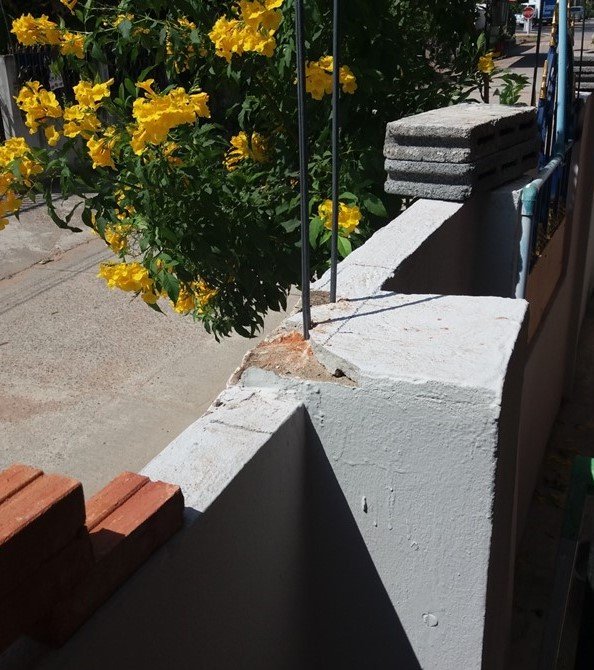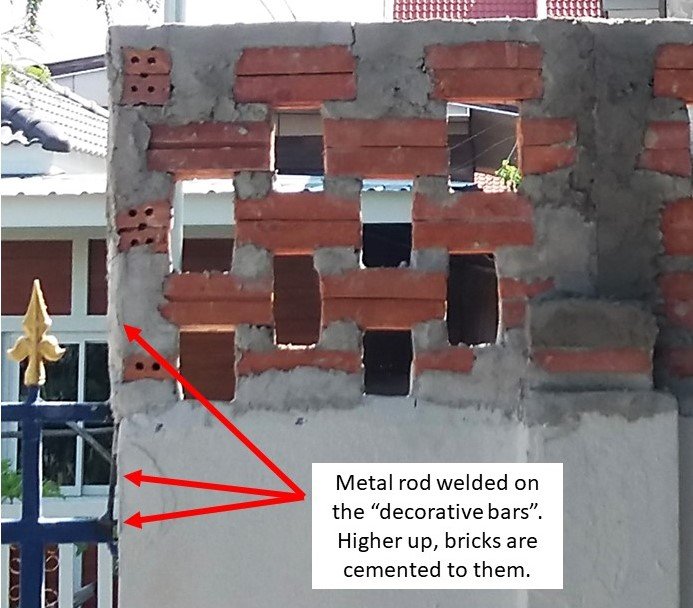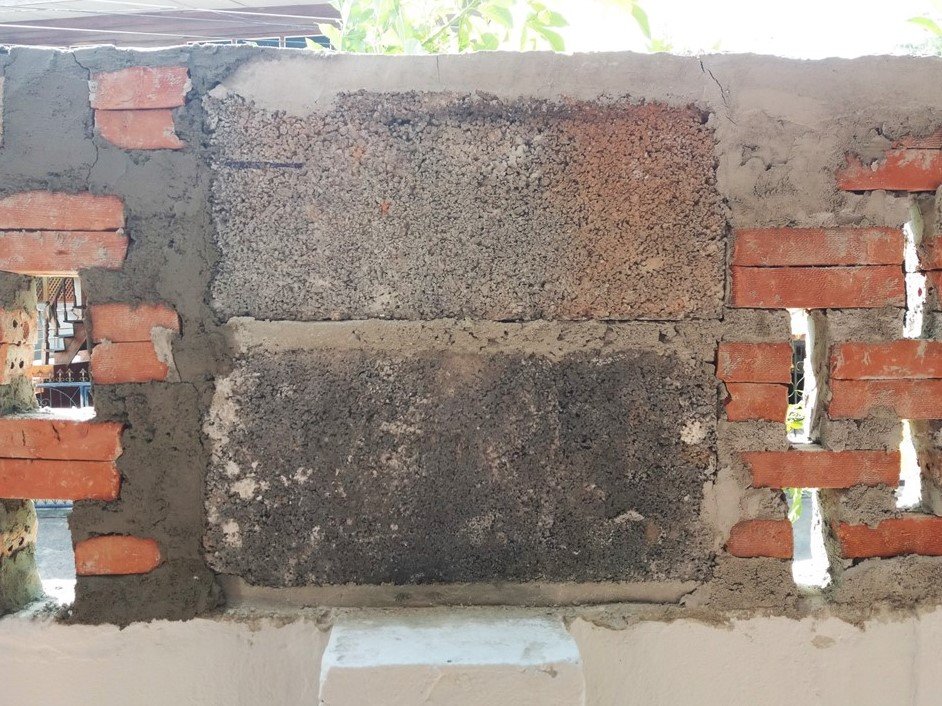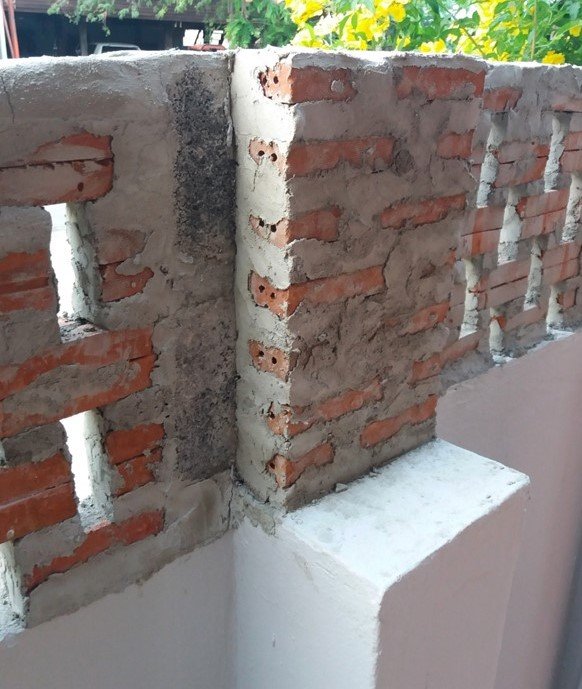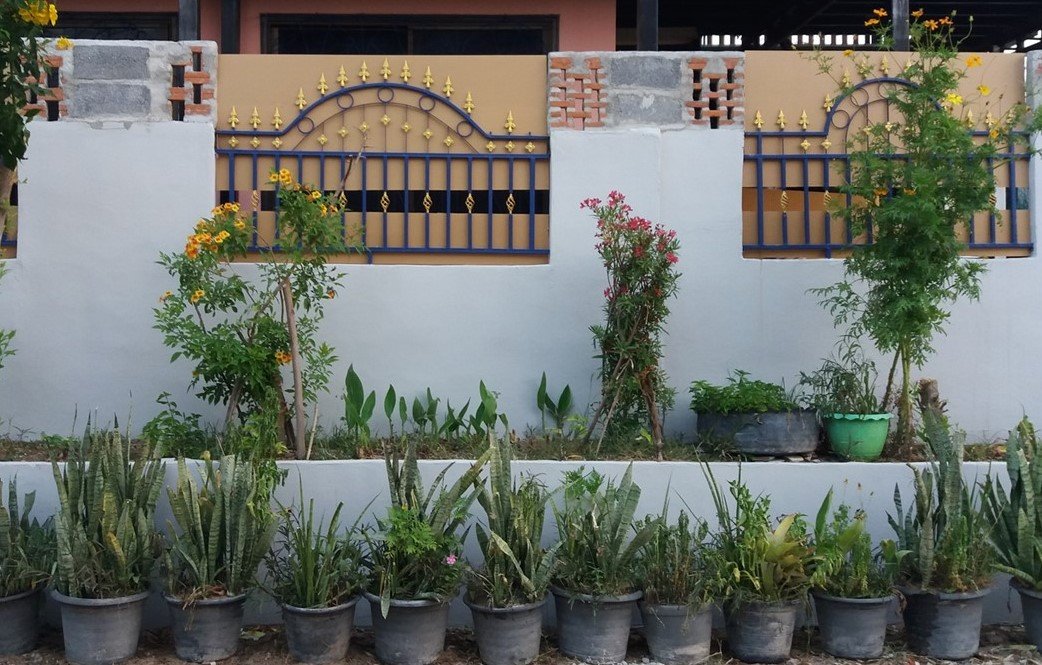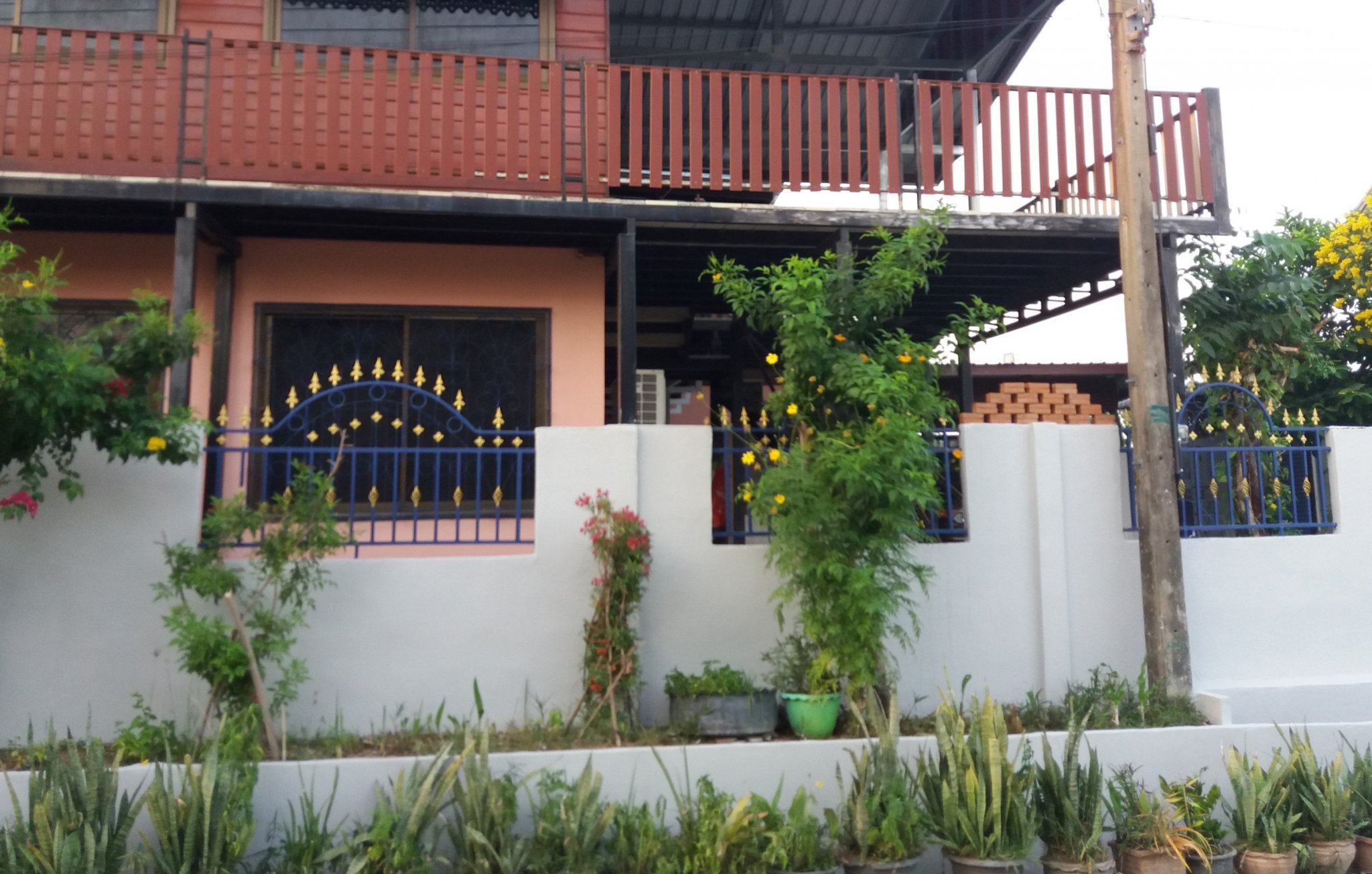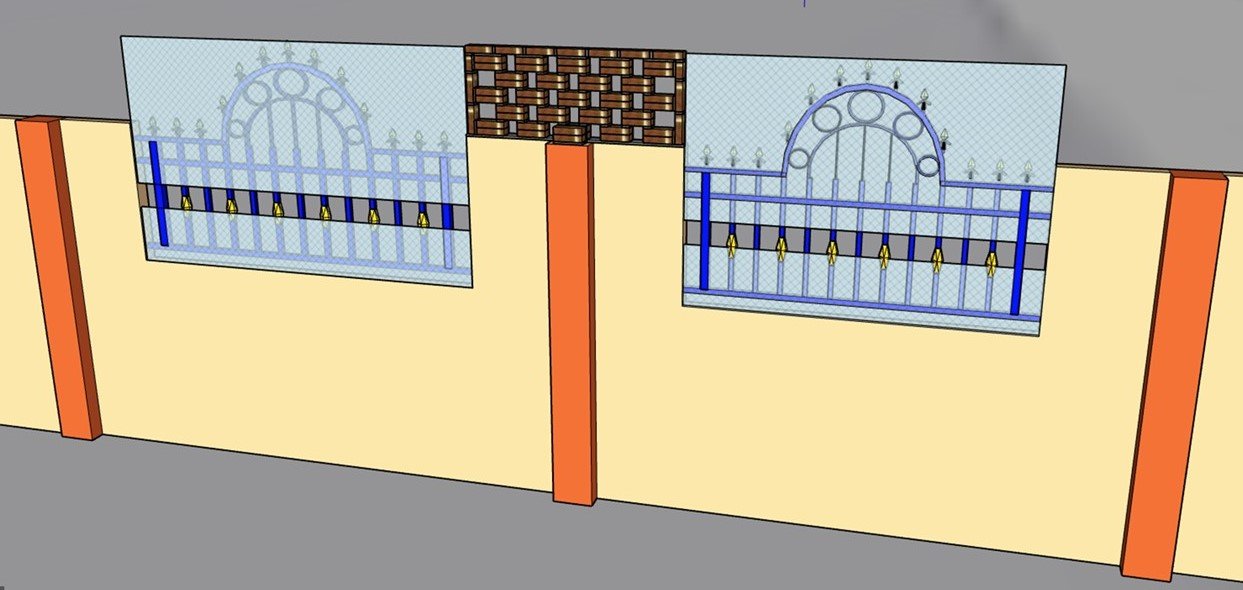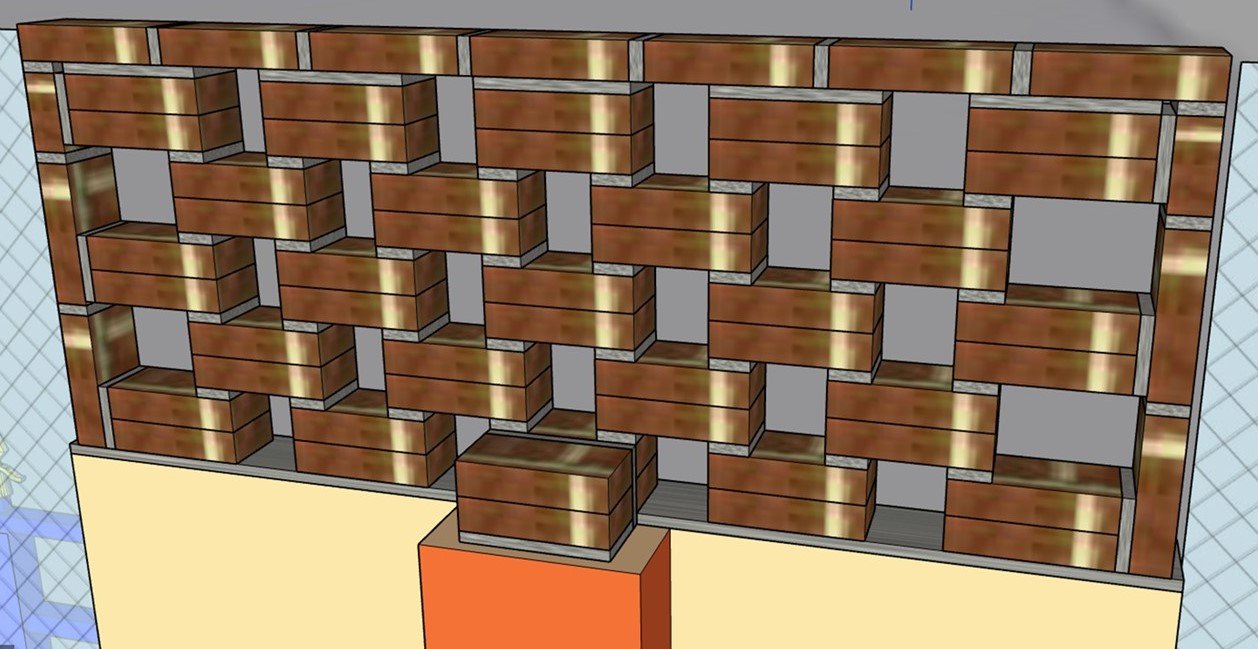.jpg.0f9a7f0a708648473981880fefc9a7c0.jpg)
gejohesch
Advanced Member-
Posts
757 -
Joined
-
Last visited
Content Type
Events
Forums
Downloads
Quizzes
Gallery
Blogs
Everything posted by gejohesch
-
Confused re 45 day VOE
gejohesch replied to rogerpattaya's topic in Thai Visas, Residency, and Work Permits
There is a risk with long haul flights as well. I've been asked 2 or 3 times in the past to show an onward reservation when checking in at different airports in Europe (never tried from the UK - saying this as many here are Brits, it seems). Luckily, every time, I actually had one such reservation ready at hand. -
2 or 3 weeks later…. Here is an update on my project. I attach 5 pics to illustrate. Pic 1: I decided to use “blocks” on the pillars, anchored on metal rods. The rods are hammered into 1 1/2 inch holes (about) that were drilled in the pillars (with a bit of chipping off here and there, but nothing that could not be easily repaired with cement later on).These are the standard grey “blocks” found everywhere in Thailand – as can be seen lying on the wall, ready to be put in place. Pic 2: Away from the pillars, I used red bricks. At the ends of each bricked up section, where the wall is interrupted by the “decorative bars”, the bricks were cemented on to metal rods that were welded onto the metal frame of the “decorative bars”. Pic 3: The resulting wall addition : grey blocks on the pillars, red bricks away from the pillars. Pic 4: To add further strength to the blocks, I bricked them up – making use of the space still available on the pillars. Pic 5: A view from the street side. As I was working with a local handyman, there was a bit of variation in the work. On the left side, sets of 2 bricks were used (glued together beforehand using Bestbond glue). On the right side, single red bricks. Nothing wrong with a bit of inconsistency, it adds charm to the construction! ????As for the segments with the “decorative bars”, I screwed in acrylic sheets (3mm thick). I had to leave space open across the “golden spires” because they protrude either side of the frame. I forgot to mention that we mixed a bit of bonding product (TOA) with the cement. I liked the cement texture that way, it’s easier to use I find and it is supposed to give extra strength to the cement. This gives a good idea of what I managed to make. It’s not finished yet, I need to think of the “cosmetics”, i.e. rendering with cement and eventually painting up like the existing wall underneath. I think that 1) the construction is very solid – no risk to get knocked over by strong winds; 2) it ends up being pleasant enough to the eye; and 3) it will not completely protect the house from the heat of the sun (but my wife is already pleased with the extra shadow ????), nor completely protect the house from the rain (but it will stop some of it for sure!).
-
I'm a EU citizen. I flew in to Thailand mid January and stayed 45 days, in line with the visa exemption scheme. For personal reasons, I need to get back to Thailand early April (again by air). My question is whether the visa exemption period will still be 45 days, and not changed back to 30 days as it used to be previously. I need to know that so I can book my flights accordingly. My understanding is that I can enter Thailand several times a year if flying in - whereas it's limited to twice a year if by land. I will most likely want to come back to Thailand, again, later in the year, most likely end August to September or October, either on a visa exemption period or maybe that time I will arrange for a TR visa for a longer stay i.e. beyond 45 days. Another question then is whether that makes sense. Thanks in advance for your comments!
-
Maybe not as effective an institution as could be desired, however it's an excellent platform to vent out issues and to see where the various countries stand on important international issues. Not that useless at all!
-
That says it all
-
In which bubble are you living? It's all over the news. Just at random, from a 2 minutes google search: Russian lawmaker warns Poland is next in line for 'denazification after Ukraine' | Fox News and that on Fox News of all possible sources, the "News" where people like Tucker Carlson are spilling their pro-Russian propaganda every single day. Russian Analyst Says to Nuke Yellowstone (businessinsider.com) bne IntelliNews - Russian foreign minister speaks of Moldova as the “next Ukraine” He mentions Moldova would be the next country "the West" plans to bring under its "domination", which will of course give Russia the pretext to attack that country and to "denazify" it. Because in the Russian raethoric, anyone who dos not bend the knee to Putin is a "nazi"! As for causing a nuclear tsunami to destriy the whole of the British Isles, it's been repeated so many times over the last few months... Now, of course, you may argue that these are all fake news. Like people arguing that all the pics of devastation in Ukraine are fake, or caused by the Ukrainians themselves. This has become as improbable as the earth being flat or the universe having been created 6,537 years, 3 months and 22 days ago (or sthg like that)? Up to you, but be sure to be on the right side!
-
Ans btw, I don't buy that BS about Ukraine being Russian land by right because of the historic origins Russia. Yes, it's true that at the beginning, and more or less until the Mongol invasions, there was the so-called "Kievan Rus' ", with embryonic northern branches such as Novgorod and Moscow. Russia per se started developing later on, centered on Moscow. Does that give Russia a rightful claim on Ukraine? No way! As a matter of fact, Ukrainians can just as well claim Kievan Rus' as their origins! Just imagine that the French population of Quebec would claim that, their historic origins being in France, that does give them the right to deny France the right to exist!!!!! That's just an example, one can just as well consider the anglo-saxon population of the USA deciding to aggress Europe because "that's where they came from"? What sort of madness is that?
-
There may have been some wrong done by the Ukrainians, who knows? I certainly don't know. But regardless, nothing can justify the barbaric aggression against Ukraine. And it has become clearer by the day that protecting ethnic Russians is only a pretext, what with all those delirious and repeated statements that "Moldova will be next, and/or Poland" and also "we will bomb Berlin and London" and recently even "let's nuke the San Andreas Fault and the Yellowstone mega-volcano to kill as many Americans as possible", in any odd order one would like? This is madness like has not been seen before. Regardless of any wrongdoings by the Ukraine, and possibly NATO and/or the EU etc, no, absolutely nothing justifies the Russian aggression and demented raethoric. I used to have sympathies for things Russian, I find it difficult to keep my sympathies alive!
-
Maybe, but demonstrates clearly how isolated Russia has become, in spite of all their BS raethoric and the pseudo-diplomatic drivel of Lavrov
-
I'm not going to mention your "experiment" to my wife, she might get the wrong idea.... ????????
-
Hmmmm.... thanks for your useful comments. The wall as is is certainly very strong, been there for several years and never moved - it is "anchored" by several pillars along its length (on average 1 every metre of "full" wall), a massive pillar at one end (leading to the gate on the other side) and at the other end by the wall that separates us from the neighbour. I will make sure the "addition" is made strong. Certainly, I will use the existing pillars as a base to reinforce the brickwork as much as possible. Maybe I should consider placing metal rods at each end of the brick sections to add further strength?
-
"rain water seeping through the wall" As said many times already, that is not the problem. It's a perfect tight and solid wall. The problem is that it only about 2m high in its "full" sections, and 1m high where it gets interrupted by the "decorative bars". It is a wall that separates the compound from the street, it's not the wall of the house itself. The problem is that when it rains - and it tends to rain rather violently around here - a lot of water washes over it into the compound.
-
You're right, but I'm not expecting to stop the rain altogether, just to get less of it coming over the wall. Plus, the intention is also to provide some extra shade. Finally, we are planning to renovate the roof next year or two, and by then we will make the eaves a bit longer, that should also help a bit. Nothing is perfect unless one puts up the price. Being in Isan, I'm happy with half-way solutions. Sure, my wife's 2-houses compound needs a lot of work up, but it's already a very lovely place, spacious, clean and pleasant. ????
-
Thanks. True, sand / cement mortar gets used for a good reason. But in my case, I'm not going to build a house or .... a Roman bridge with the bricks ????. I'm only increasing the wall height by 40 cm, and in sections varying between 1m and 3.5m with reinforcing pillars. I'm not designing to resist artillery fire! I mention "Roman bridge" because Romans were the inventors of cement and mortar, believe it or not Roman stuff is still being studied for their quality, I remember reading about it recently, sthg about how they got some component at the right temperature before mixing or sthg like that (I did not go too deep into the explanations).
-
Makes sense, but sounds a bot drastic. I actually like to keep those decorative bars ???? But thanks for your input!
-
"Surely the purpose of a boundary wall is to provide physical security or aesthetics and not prevent rain?" Sure, by why not also some protection against the rain? .... and against the heat of the thai day time, by providing some shade? Is there a building code that prohibits that???? "Can you not simply lay a path (concrete or brick) on the inside of the wall with a slight incline down to drain which rain water runs into to divert away the excess water and problem solved?" As said above, there is a pathway between the wall and the house. Its width varies between 1.2m at one end and 1.5m at the other end of the house. I already have some drainage in place. What I'm concerned about is 2 things: 1 - so much rain that regardless of the drainage, when it rains heavily (I suppose you know of the thai weather?), a lot of water washes over the wall (as it is) and in the long run, the house wall gets so regularly drenched that the paint gets damaged etc. 2 - maybe more importantly, as the house on that side faces due south, it gets a lot of direct sunshine. In a temperate climate, that would be a good thing, but (again) with the brutal thai climate, I personally would appreciate a bit more shade than the one provided by the wall as it is. It is for these 2 reasons, and considering that the wall is actually made of a series of segments interrupted by the "decorative" fencing (no shade and no protection against the rain whatsoever), that I am planning a) to close up the fencing sections with acrylic sheets (I have started and it works well); and b) add height to the full wall sections with brickwork (what I believe is called "perforated façade" style). All this may sound long and wordy. A look at the pics I have posted will make everything so much clearer.
-
I was thinking more about the regulations and the distance between a house and the street. Everywhere in this country, one can see roadwork on the way, much of it widening the initial roads. One could not count how many houses were initially located a few metres away from a road and that all of a sudden find themselves that much closer to the "improved" road. That certainly also happens within the villages. It just happens that my wife's street is the widest one in her village, so I can conjecture that going back in time it may well have been narrower - and obviously the house would have been a bit further away from the initial street.
-
Thanks for your long reply, but I think you misunderstood me, or maybe I was not clear enough? I thought the pics would help making the whole story clear... It's a wall along the street but not a wall of the house as such, and as I said above, there is a 1.2 to 1.5m space between the wall and the house - it's a pathway around the house. My problem is not that the wall "lets water filter through" but that the wall not being that high, a lot of rain gets over it during the rainy season, so the pathway gets very wet, sometimes even flooded. And the damage caused to the house is that the base of the house wall gets very wet also, which with time is not a very good thing either. Further, there is no problem at all with ground moisture coming up. And I never said that I could not add pillars. I just said that there are pillars here and there along the wall to reinforce it, and that I could use those reinforcements as the base on which I could make my brick work wider, hence stronger. For example, the longest wall section (between the spaces with the decorative fencing) is 3.5 m long but that includes 3 such pillars / reinforcements. I add a pic showing the wall in question (light grey). The "decorative" fencing is in blue with details painted gold. I have stacked up a few bricks on the right hand side to check the visual effect I can get, but I have not cemented any yet. I would anyway build the bricks higher, to level up with the top of the fencing. The house is behind (walls in pink / orange).
-
Thanks, the thing is I want no space between the 2 bricks. With any type of mortar, there would be a join with some thickness (at least 8-10mm I think) and that would make my original design inapplicable, as I want the total height to reach the level of the acrylic sheets and top of the fencing. OK, I can always come up with a different design, there are many variations possible .....
-
You may be right in theory, but no one seems to care with that around where I live. That house and the wall by the street were built so many years back anyway, if anyone had an issue, we would have known a long time ago! The distance from the house to the street wall varies between 1.5m and 1.2m. It runs at an angle, I don't know why but people don't seem to like straight lines nor parallel lines in this country! They don't seem to care much about vertical lines either, come to think about it.... ????
-
Thanks. Do I find that in Home Pro or Global House?
-
My idea is not to use glue throughout (in which case I understand it would not be that strong). Glue only for to make sets of 2 bricks, and then mortar to assemble the sets (see my pics). Because 1) that would make me get to the desired height; 2) there would be less mortar work, and less messing up of the bricks with mortar everywhere (I want the bricks to keep their original red surface for aesthetic reasons). Understand, I'm not a pro, so less mortar work is better for me, and I can glue the sets of bricks comfortably sitting somewhere, before getting to the follow up work on the wall. I'm not a pro but I prefer to do the work myself even if it takes time. I would not trust a local "châng" to do the work cleanly.
-
I'm "upgrading" my wife's 2 houses compound. It's very nice and spacious enough, in a quiet and rather clean street in a small village in Isan. The wall by the street is in a good condition but the first house is less than 2 metres from the wall and there are 2 problems : when it rains, too much water gets over the wall and with time damages the house (mold etc); the house is south-facing and when the weather is hot, the wall does not provide sufficient shade to my liking. The wall is actually not a simple, continuous walls. It is interrupted by spaces with a "decorative" style of fencing. The fencing is higher then the wall by a good foot or so - see the first pic. I have started fitting acrylic sheets along the fencing parts, to stop at least some of the rain. The acrylic sheets is what I have represented as semi-transparent panels on the first pic. If I don't do anything else, the result will not look elegant in my sense, the sheets sticking out a bit like a sore thumb. So I have decided to add a few runs of bricks on top of the existing wall, to come up to the same level as the fencing and acrylic sheets. That will also provide extra shade and extra protection against the rain. The brick pattern I have come up with is as shown on the 2nd and 3d pics. Using the standard red bricks one can find everywhere in Isan. The wall varies between 7 and 8 cm thickness (it's Isan-built ????), which is just enough to seat the bricks on. I have modeled the pattern with mortar joints of 1cm thickness. For that pattern, I think of gluing bricks in pairs. My question then (apologies for the long introduction) is : which product to use for gluing the bricks can I find around here? Would any all-purpose glue do, or is there anything better? By the way, one comment that may come up is how am I going to add strength to the bricks? Normally, I think, one would build a pillar at both ends, but that's not possible in this case (again, see the pics). However, the runs will not be that long - they will vary between 1 and 3.5 metres along the wall (the wall is rather irregular, again : Isan-built ????). Also, there are a number of pillars in the wall (in orange on the pics) which provide extra space that I can use to add bricks by the side of the brick runs - see pic 3 - to add a bit of strength. Recommendations re. the gluing product, and other comments, will be very appreciated. Thanks in advance!

